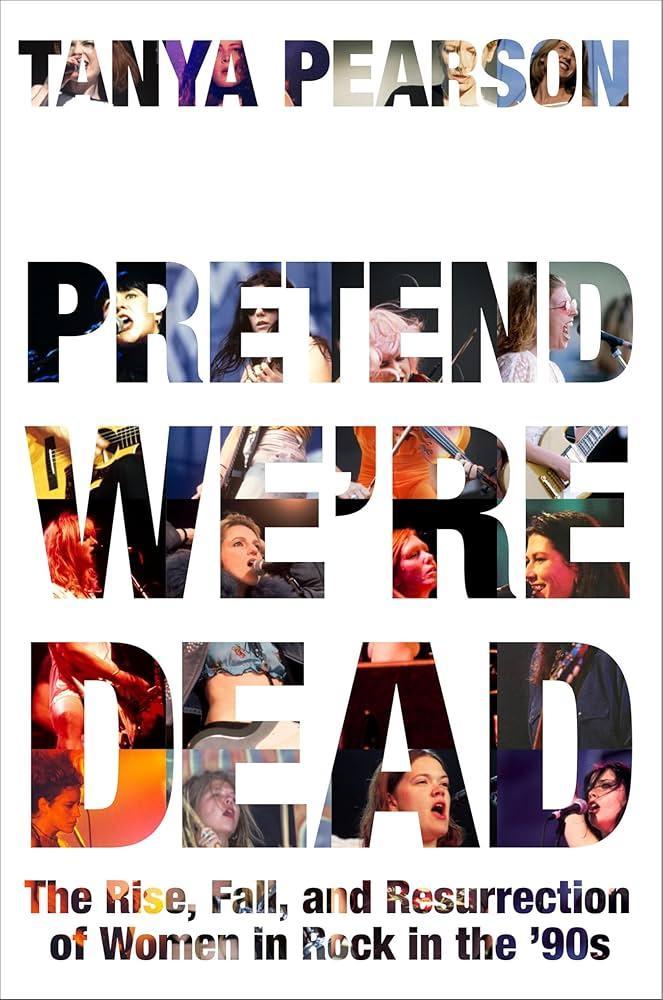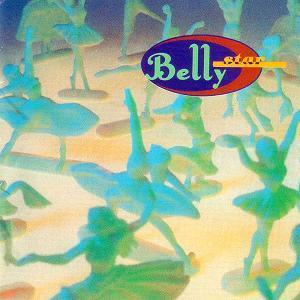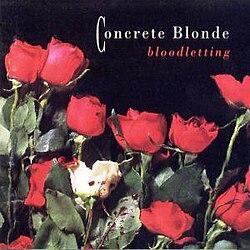GO ON TAKE EVERYTHING
A Critique/Review of “Pretend We’re Dead” by
By Granny Anarchy

What'supwithwhat's goingdown? Ineverycity,inevery town Crampingstylesisthe plan They'vegotusinthepalm ofeveryhand...
Tanya Pearson
Turn the tables with our unity They'reneithermoralnor majority Wakeupandsmellthe coffee Orjustsaynoto individuality Whenwepretendthatwe're dead (https://tinyurl.com/2zdfayp8)

(L7 performing at the Emerson Theater in Indianapolis in 1997, via Wikipedia)
Granny Anarchy is Gen-X, and a smidge older than Xennial author Tanya Pearson. Our musical tastes and the way we approach writing also diverge, and I wonder how
much of it is due to (slight) generational differences.
The first thing one should know is that the song “Pretend We’re Dead” was written by Donita Sparks of L7 as a(n unintended) reaction to Reagan/Bush era apathy (https://tinyurl.com/33r4c vzr)

Since Sparks chose the name L7 deliberately to be without gender and isn’t completely happy about being segregated and lumped in with profiles such as “Women in Rock,” choosing her song title for a book about women in music, their rise in prominence and diversity of styles, and their subsequent shrinkage of market share and (re)subjugation to male
gaze gender norm ins a post-911 world may not be completely apt. However, it is eerie to contrast Reagan’s “Moral Majority” with today’s Trumpian takeover, which has allowed Christian Nationalism to appear far more prevalent - and wipe away so many of the gains women, LGBTQ+, and POC have made in and since the 1990s.
Tanya Pearson is a historian and founder of the Women of Rock Oral History Project (https://tinyurl.com/ynd4h a82). She has amassed research and collected interviews and digital transcripts. In Pretend We’re Dead, she explores how the disparate, varied and thriving culture of pre 9/11 gave way to a more stifled misogynistic music scene. Pearson gives particular attention to Belly, Tracy Bonham, Garbage, Hole, Luscious Jackson, Liz Phair, Sonic Youth, The Breeders, Throwing Muses, and Veruca Salt. There are mentions of acts such as Babes in Toyland, PJ Harvey,
Juliana Hatfield, Mazzy Star. Alanis Morissette, and Peaches. However, Pearson specifically states she that won’t be writing about Riot Grrrls and there are a plethora of women artists who were – whether we liked them or not – extremely seen, heard, and active in the time period covered (roughly the 1990s grunge era through the 2000s NYC/emo scene) that have mysteriously been left out of this somewhat slender (approximately 245 page hardback) volume. These glaring holes and glossedover careers of wild, subversive, genre-bending and game-changing women do Pearson and her pseudo sample a disservice. Although her book is an extended essay and not a scientific study - if you take one of the basic rules of studies, it is: sample size matters. The smaller your sample, the more inaccurate and questionable your results. Pearson makes terrific points. But her narrow focus in regard to artists greatly hinders her
credibility. She has published a timely, worthy premise, but leaves us with a book that is shy of a five-star recommendation, as her limited, restricted focus feels cherry-picked - and is therefore fodder for accusation as to the accuracy of her results, nullifying – or at least calling the validity of her argument into question. This is a shame, as I enthusiastically and wholeheartedly agree with her findings and would appreciate more solid presentations to back up her limited argument and shown work.
Allow Granny to share with you some of the interesting information and opinions found inside this tome available at Metro Library: (I have added graphics and my own comments!)
“I interviewed Shirley Manson, iconic redhead and vocalist of the seminal '90s rock band Garbage…she discussed her childhood, upbringing, and musical trajectory, but she also made a provocative statement: "It's a
blanket fact that after September 11, nonconformist women were taken off the radio." I wouldn't have put it in these terms, but what Manson said accorded directly to my own experience of listening to the radio and watching TV”
There was no room for rebellious, feminist women; domestic femininity was used to repurpose and commodify the subversive messages of alternative culture and turn them into something more profitable like the Spice Girls (Girl Power!) and Avril Lavigne's skater boi corporate pop punk schtick. The 2000s marked the rise of hypersexualized yet arguably autonomous female pop stars like Britney Spears and Christina Aguilera, Even Madonna toned it down!
(Ray of Light Era 1998.)

(Nirvana in skirts)
The death of Kurt Cobain marked an end of mainstream feminist men. By 1997, frat-boy nu metal rose to prominence…and Woodstock '99 marked the end of a generation. The Telecommunications Act of 1996 allowed corporations to buy as many radio stations as they wanted…College radio stations, women-centered stations, and Black radio stations were the primary victims…The creation of corporate media behemoths like Clear Channel coincided with the rise of nu metal, and women who had been chart-topping successes could no longer get airplay. Record labels also experienced massive consolidation…Representatives were fired; bands were moved from one label to another without their consent and…weren't being supported…Finally, there was vocal backlash against third-wave feminism.
Indie and alternative rock today is constrained by corporate overlords, social media culture, and an infatuation with the self and personal identity. Consequently, lyrical navel-gazing is the norm, and everyone kind of
looks and sounds alike. Part of what made the '90s so unique is the breadth and diversity of the artists within the genre, but also the breadth, diversity, and nuance of its feminism…
Presently, mainstream music is a homogenized product, a direct result of media and record-label consolidation that began in the mid-1990s. Pop music presently follows a distinct pattern, is produced by a handful of people, and generally sounds the same.

(Belly, Star, recorded at Fort Apache)
Belly's first album, those songs were supposed to be a Breeders album. It was supposed to be the second Breeders album. And in fact, the demos from Fort Apache for those songs say "Breeders" on
them.
Kim came in and did a few of them with me as we were getting ready. Kim, at that point, was going to leave the Pixies, and I was going to leave Throwing Muses. Meg can use 'em, we can do something with 'em
We'll make something out of 'em
Make some money out of 'em at least!
The boycott of the [Dixie] Chicks is perhaps the most memorable incident of major fallout experienced by dissenting women in music following 9/11. [O]ther music veterans spoke out… without consequence. Willie Nelson proposed… 9/11 was a government conspiracy… to drum up public support for a war in Iraq. Merle Haggard released an anti-war song … Neil Young released an entire anti-war album… and Crosby, Stills, Nash & Young reunited for the North American Freedom of Speech Tour using the Iraq War as the backdrop… [Yet] radio DJs and programmers who sympathized with the band were forced to stop playing them,
and some who continued giving the Chicks airtime were fired. In true democratic fashion, George W. Bush addressed the backlash in April 2003:
The Dixie Chicks are free to speak their mind. They can say what they want… They shouldn't have their feelings hurt just because some people don't want to buy their records when they speak out. Freedom is a twoway street. I don't really care what the Dixie Chicks said. I want to do what I think is right for the American people, and if some singers or Hollywood stars feel like speaking out, that's fine. That's the great thing about America. It stands in stark contrast to Iraq.
The boycott led to the virtual demise of the band. They released Taking the Long Way in 2006 before going on hiatus. Clinton signed the Telecommunications Act into law in 1906. Within hours of the act's passage, the radio industry was overtaken by a feeding frenzy of
acquisitions, as… corporations moved to buy as many stations as they could. While Clinton debated the meaning of sexual relations…college radio, whichbefore the ubiquity of household internet and social media-had been a primary source of promotion for underground bands, disappeared. Black and womencentered stations were also victims of corporate consolidation. According to a lengthy report published in 2006 by the Future of Music Coalition, in 1995, Clear Channel owned 39 radio stations, more than any other corporation in America. Five years later, they owned 1,100.

Woodstock '99 epitomized a violent shift from national feminism to national misogyny…The gender parity and diversity highlighted at Woodstock '94 had been usurped by nu metal
and frat-boy rape culture. The legacy of the festival remains one of corporate greed, misogyny, sexual assault, and fires…Oh, and only three women performed, but who's counting?

[W]ithout provocation and for no reason other than "the physical discomfort of entitled, frustrated white men who had never been inconvenienced in any remarkable way before." What Woodstock did was put all those dudes in an enclosed…area where they could anonymously destroy their surroundings and rape women against a soundtrack that encouraged that behavior. But this shit happens all the time at concerts and festivals. It's the anonymity-whether behind a computer screen or invisible in a crowd-that gives the entitled license to be cruel. But it's the entitlement itself that's the root
of the problem. White men feel entitled to certain things-certain inalienable rights, if you will and expect their God-given position at the tippy-top of the social pyramid… White, middle-class men feel helpless, unappreciated, disregarded, and threatened when women achieve any type of progress. And women in rock in the 1990s made that progress.
For people without access to higher education, the internet, or even the physical proximity to countercultures and subcultures-or for those with only access to mainstream media representation and gender parity in media matter a great deal… marginalized subjects-women, people of color, queer, trans, and gender nonconforming artists are further marginalized by being siphoned off into supplemental categories, subjugating them as the "other" and keeping their access to wider audiences out of reach. Representations of women in media drastically shift during moments of war and political conflict.
Tracy Bonham: I think maybe even the bigger situation would be that the radio changed. Everything now was like angry white boys with baseball caps backwards, Limp Bizkit. I think there was a backlash, and I'm not saying this because I'm bitter. It's just that there was this whole, you know, "women in rock" thing, and I was constantly fielding these questions: "What does it feel like to be a woman in rock? (What’s it like to be a man in rock?)

Chrissie Hynde of The Pretenders,
Debbie Harry of Blondie, Poly Styrene of X-Ray Spex , Viv Albertine of The Slits, Siouxsie Sioux of Siouxsie And The Banshees and Pauline Black of The Selecter
Courtesy Granny Anarchy’s closet door (I have had this photo for 25+ years I don’t know where I got it.)
THE SCARCITY MYTH-THAT THERE'S ONLY ENOUGH ROOM FOR ONE or two women at a time-creates a culture of competition… perpetuated in the media. In a capitalist economy… dependent on sexual divisions of labor, mainstream rock media exists to serve the interests of the ruling class: rich white men. The scarcity myth is a tool designed to devalue women's contribution in what is still considered a male-dominated industry. We're all aware of the "mean girls" trope: women are jealous and tear one another down. They don't support one another. They gossip, scheme, and catfight. Men don't have to … because there's room for all of them, all the time…
I saw Liz Phair at a club in Boston in 2018. She brought Juliana Hatfield … and they both acknowledged… they competed because of the scarcity myth.
Meanwhile, there were nine thousand male-fronted bands trying to sound like Eddie Vedder…there was room for all that…. I seriously doubt that Stone Temple Pilots or Bush…sat in a meeting with their management and were told that their singles were being held back because there were too many men on the radio…By the late '90s, women were told this repeatedly.
Women suffer more when markets are consolidated or privatized, and women in rock certainly felt the effects of record-label consolidation in the mid-1990s. The global music business constitutes a powerful oligopoly-a market condition in which a few firms dominate most of an industry's production and distribution. Major record labels make up over 85 percent of the music industry. In the 1990s, the Big Four major record labels…were EMI, Sony Music Entertainment, Universal Music Group, and Warner Music Group. Universal Music purchased EMI in 2012, leaving the Big Three: Sony BMG, Universal Music Group, and Warner Music Group. Major labels oversee
subsidiary labels…giving consumers and music fans the illusion of choice. It's like walking into a grocery store. What's on the shelves may give the perception of endless options and brands, but really, a handful of companies control a vast majority of sales.

When "poor performance" closed a subsidiary, its artists would be distributed among the other subsidiaries under the major label. In this respect, the hierarchical structure of a major label can be quite complex and draped in secrecy, with bands being moved from label to label without their knowledge or consent. At the end of the 1990s, women in rock found themselves in this predicament.
(I distinctly remember working at B. Dalton Books in Penn Square Mall ranting AT LENGTH in the back room about this!!! ↓) The Telecommunications Act
enabled Clear Channel-now the iHeartRadio / Live Nation conglomerate to become a behemoth. Seldom in the annals of American history has a piece of legislation with such widereaching consequences passed with such little public notice, in no small part because the media companies that might have reported on it critically had an interest in not doing so. Before the proliferation of household internet in the early 1990s and social media, college radio had been the primary source of promotion for underground bands. By and large, it disappeared. Black- and womencentered stations were also victims of corporate consolidation…The ways in which [Clear Channel] cut costs and boosted profits, and their conservative political leanings… gained them a reputation for corporate villainy.
After 9/11, rock radio served to uphold new national interestsstate-sanctioned surveillance, patriotism, nationalism, and antifeminism. Censorship and restrictions on artistic expression are most effective when …
imposed within a highly concentrated marketplace directed by the federal government, and the corporate consolidation of radio reached its peak after September 11, 2001, with Clear Channel owning and operating radio stations and businesses in over sixty countries. The owners of Clear Channel had a bond with the Bush administration and the Carlyle Group, a global private equity firm with George Bush Sr. on its payroll. This led to an alliance of conservative agendas and censorship illustrated in the 4,164 songs that were banned from American Radio after 9 /11*. The rise of Clear Channel coincided with the "cultural troika" of media, entertainment, and advertising, declaring the post9/11 age an era of neo-'50s nuclear family, domesticated femininity, and Cold War warrior manhood. Although male musicians were also victims of censorship, women suffered the additional backlash against thirdwave feminism after 9/11 and ensuing, albeit ambiguous, war on terror.

* See Granny’s Zine About Censored Music!
https://tinyurl.com/5bed589p
Throughout American history, in the wake of war or global conflict, marginalized people are blamed for the collapse of American values thought to keep the country safe. Japanese Americans were interned during World War II; gay people were subject to scrutiny and fired from their government jobs during the Lavender Scare; in the 1980s, Black women were branded "welfare queens"; and women remain consistent targets of the conservative ideologies of Republican motherhood/cult of domesticity. During times of national panic, women are urged to return to their "natural" place, at home, barefoot, and pregnant definitely not with electric
guitars. Because non-conformist women, as a group, reached the formerly unreachable heights of mainstream visibility in the 1990s, they had to be intentionally submerged beneath the banality of patriotic country music, nostalgic indie rock, and harmless pop. New forms of femininity-the sexy, barely legal kind-were promoted. Old, stereotypical rock gods regained their rightful places on magazine covers, and boy bands reintroduced the male gaze, six-packs, and air humping.
Post-9/11 radio played … male indie rock, sad-boy emo, and the remaining rock women who survived the backlash and carved out space for themselves in the post-9/11 landscape. Sheryl Crow transitioned fully to adult contemporary and even released a country-inspired duet with the biggest asshole on the planet, Kid Rock, in 2001; Liz Phair went corporate pop punk with her 2003 album Liz Phair…Avril Lavigne's skater boi punk was molded out of the most palatable relics of alternative music; Gwen Stefani released her first massively successful solo album (Love.
Angel. Music. Baby.) in 2004…By the mid-2000s, hypermasculine misogynist rock receded and gave way to a wave of predominantly male, vintage-inspired indie rock. Bands like the Strokes, the Hives, and the White Stripes performed lo-fi nostalgia on MTV and Saturday Night Live, while singersongwriters like Elliot Smith (who is great) and Ryan Adams (who sucks) found commercial [success.]
Whew! That’s a lot! And there is much more in the book that is really worth taking a look at –especially as one sees the rights of women (reproductive, voting) and people of color (deportation, detention, ICE raids, law enforcement harassment) – not to mention the humanization and healthcare of LGBTQIA+ community being not only eroded but that normalization of their degradation and erasure being shrugged at and swept under the rug by media and politicians, those new values being acclimatized into new generations. -
My main quibble is that small sample, that limited focus.
Missing from or barely mentioned in Pretend We're Dead:
Many of these artists were all over the airwaves and overflowing into other media in the early to mid 1990s, but as the decade waned and into the 2000s, although some continued their careers, their alternative and mainstream support slid, still proving Pearson’s point. Their inclusion in Pretend We’re Dead would have only added to her argument. (band/artist – yearof album“bigsingle”)
4 Non Blondes / Linda
Perry - "What's Up" 1993
Tori Amos - 1992, 1994, "Caught A Lite Sneeze" 1996, 1999
Fiona Apple - "Criminal" 1996, "Paper Bag" 1999
Bif Naked - 1998
Bjork (/The Sugarcubes)"Human Behavior" 1993 "Army of Me" 1995
Edie Brickell - 1990, 2000, 2002, 2006
Meredith Brooks - "Bitch" 1997

(Concrete Blonde, Bloodletting, 1990.)
Concrete Blonde / Johnette Napolitano - 1987 "Still in Hollywood," 1990 "Joey," 1992 "Walking in London," 1994 "Mexican Moon"
Ani DiFranco - 1995, 1996, 1998
Chrissie Hynde (/The Pretenders) - 1990, 1994, 1999, 2002, 2008
Jewel - 1995, 1998
Joan Jett – 1990, 1991, 1993, 1994, 2004, 2006
Le Tigre (not Riot Grrrl, which she said she wasn't including so not really an excuse) – 1999 "Deceptacon"
Letters to Cleo - "Here and Now" 1993
Aimee Mann (/Til Tuesday) - 1993, 1996
No Doubt – 1995 "Don't Speak"
The Cranberries - I HATE
THESE SONGS but unlike SOME authors I’m proving a
point. 1993 "Linger" 1994 "Zombie"
The Donnas - 1997, 1998, 1999

(Patricia Morrison via Wikipedia)
Although perhaps beyond Person’s focus, “uncompromising, unapologetic, strong, shocking, rowdy, eclectic” women led the way in gothic rock, where there was perhaps more tolerance for female influence in the 1980s and 1990s. See Patricia Morrison (Sisters of Mercy) who had a full musical career before playing with Andrew Eldritch. She left the
band in 1989 for a musical hiatus, returned with a solo album in 1994, then joined The Damned in 1996. Then there’s Elizabeth Fraser of the Cocteau Twins, who released albums in 1990, 1993, and 1996. Also absent from Pearson’s inclusion is Siouxie Sioux, whose discography includes, from this era alone: Siouxie and the Banshees: Superstition 1991, The Rapture 1995 / The Creatures - Boomerang 1989, Anima/Animus 1999, Hai 2003 / Solo - Mantaray 2007.
And who is more shocking than Sinead O'Connor? She is never mentioned. Her discography includes: The Lion and the Cobra 1987 / I Do Not Want What I Haven't Got 1990 / Am I Not Your Girl? 1992 / Universal Mother 1994 / Faith and Courage 2000 / Sean-Nós Nua 2002 / Throw Down Your Arms 2005 / Theology 2007 / How About I Be Me 2012 / I'm Not Bossy, I'm the Boss - 2014
Suzanne Vega released 99.9F in 1992. Nine Objects of Desire (her 5th studio album) was released
in 1996. The single "Caramel" was featured in the movie The Truth About Cats&Dogs (1996), and later in the movie trailer for Closer (2004). Yet her name remained mostly off of pop radar.
Other brash, confrontational, defiant, groundbreaking, iconoclast, notorious, and in some cases, shy but solid artists Pearson chose to exclude or was dismissive of are:

(Deborah “Skin” Dyer, Skunk Anansie via Wikipedia)
Skunk Anansie Neko Case
Elastica Exene Cervenka/X
Tracy Chapman
Emily Haines/Metric
Lush
Karen O/The Yeah Yeah
Yeahs
Portishead
Cat Power
Sleater-Kinney
The Muffs
Meg White/The White Stripes
Of course, she deliberately left out Riot Grrrls, including
Bikini Kill (Kathleen Hanna also performed in Le Tigre and The Julie Ruin; Tobi Vail was also in The Frumpies, Spider and the Webs, GSP, and has worked behind the scenes, organized, and written with Kill Rock Stars, LadyFest, and JigSaw) Bratmobile
Heavens to Betsy and, depending on how far one wants to stretch the original genre
Dickless Calamity Jane
Lastly, although this may also be a product of mainstream media and even alternative attitude in the 1990s, there are few to no POC or trans women
and only one or two LGBTQ+ members at all (or vocal allies) in Pearson’s dozen or so main interview subjects. – especially if one doesn’t know their stated stance in advance of reading, as race, any time of queerness, or intersectionality aren’t directly addressed in interviews. Again, Pearson does stick to her (narrow) focus.
Again, with all of this criticism, why would I (rather heartily) recommend Pretend We’re Dead? Disregarding all that it leaves out, it still chronicles an intense and important time in music (And I was there, too!)– and culturalhistory. Despite its small sample size and limited focus, it gets a lot correct. It simply would benefit from more proof to shore up Pearson’s assertations. Her facts, her timeline about the Telecommunications Act of 1996, the metastasizing of Clear Channel, the monopolization and business model shift of the Big Four/Three record
companies, is accurate –and provides a clear framework to see how nu metal gave misogyny a way to shove feminism aside and how the stage was set for 9/11 to prep (most) women and society for “it’s scarytimes, let’s return to more traditional, restrictive gender norms.”
What if you’ve read (or skimmed) all of this and are thinking “that’s great’n’all, but what about CURRENT fabulous female energy in subversive (or at least loud) music? Here are some of Granny’s recommendations: Descartes a Kant Sofia Isella Lambrini Girls

(Lambrini Girls “Who Let the Dogs Out?” avail at Metro Library)
Skating Polly

(Skating Polly via Wikipedia)
Sprints
St. Vincent
The Linda Lindas
Wet Leg
As well as:
Beth Ditto
Laura Jane Grace

(Laura Jane Grace via Wikipedia)
Pussy Riot
TacoCat
See also (1980s, earlier): Viv Albertine/The Slits
Poison Ivy/The Cramps
Mia Zapata/The Gits
The Go-Gos (yes, they were badass)
